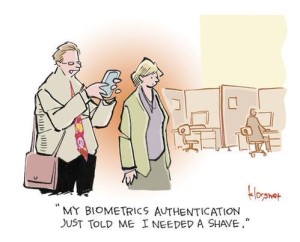 Replacing much hated (yet resilient) passwords with face recognition-based authentication has been a cool idea of ‘how things will work tomorrow’ – yet ‘tomorrow’ in terms of massive adoption never really happened. Some may argue that the stars – were not really aligned till now, but may be aligned very soon. Indeed, facial recognition methodology (naturally) keeps getting better. User-facing cameras (which just several years ago were limited to PCs equipped with an extra webcam) are now getting increasingly omnipresent – from laptops to tablets to smartphones. And the pain of remembering passwords keeps getting worse. The idea is pursued by variety of smaller companies like KeyLemon or Sensible Vision, and face recognition features even made it into Android mobile OS. Moreover, as recently as last month no one else but formidable Jack Ma demonstrated how Alipay may allow payment authorization exclusively via user’s face recognition.
Replacing much hated (yet resilient) passwords with face recognition-based authentication has been a cool idea of ‘how things will work tomorrow’ – yet ‘tomorrow’ in terms of massive adoption never really happened. Some may argue that the stars – were not really aligned till now, but may be aligned very soon. Indeed, facial recognition methodology (naturally) keeps getting better. User-facing cameras (which just several years ago were limited to PCs equipped with an extra webcam) are now getting increasingly omnipresent – from laptops to tablets to smartphones. And the pain of remembering passwords keeps getting worse. The idea is pursued by variety of smaller companies like KeyLemon or Sensible Vision, and face recognition features even made it into Android mobile OS. Moreover, as recently as last month no one else but formidable Jack Ma demonstrated how Alipay may allow payment authorization exclusively via user’s face recognition.
So… tomorrow of “authorize with a ‘faceprint’” is finally happening? I venture a prediction that it will never graduate from a cool concept to widely acceptable practice. I can mention at least two reasons why:
- As with any other authentication mechanisms, it’s going to be a cat-and-mouse game – the authentication technology will get better only to be defeated by ever-creative fraudsters. In cases when the attackers are inherently capable of moving faster than the defense, the ‘cat’ is kind of doomed. We could reach a point – just like it happened with captcha – when building more defenses may become unfeasible. How does it apply to the face recognition domain? The weakness of using face recognition for authentication purposes is nothing new – e.g. these guys nailed it back in 2009. True, the recognition software improved a lot since then, and some interesting ideas like detecting moving eyeball or blinks may offer a chance, but then again attacking these defenses to fool the software into false positives is becoming cheaper on a faster pace (3D printed masks, colored lenses, video-generated images?).
- Any change in consumer behavior on a massive scale would need a push from a very large player interested in making money on it – such as Apple (case in point: mobile payments). Apple is hardly going to do it though, as its newest devices already have fingerprint readers. While fingerprints arguably suffer from the same issues, they are much more resilient biometrics – fingerprints are way harder to obtain than pictures of the potential victims (even taking this claim into account). Moreover, if we combine this observation with dropping price of fingerprint readers, envisioning even cheaper devices having one in near future is easier than imagining face recognition used as main biometrics to identify the end users. In addition, cameras can be used to scan your fingerprints instead of your taking a picture of your face. There’s little evidence that other large companies would have enough incentives to go against this trend.
Having said that I can see how ‘faceprint’ can be used as one of choices of a biometric 2nd factor, or in some physical stores which would like to appear futuristic to its customers. Maybe even some airports. Wide adoption however may remain as ‘the cool feature of tomorrow’.